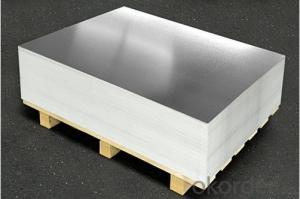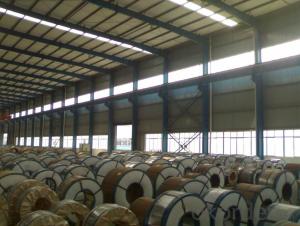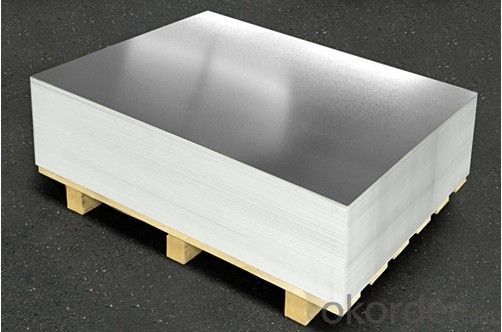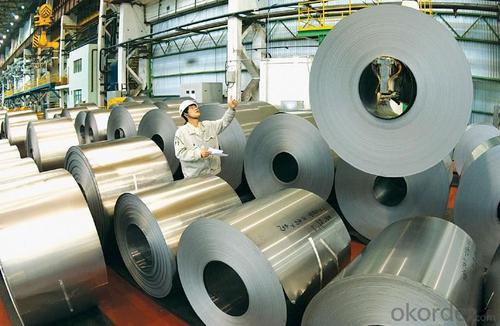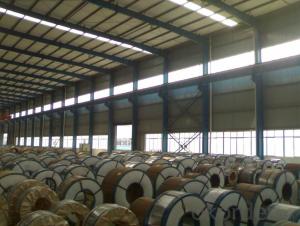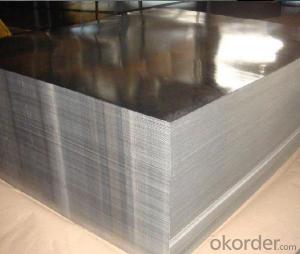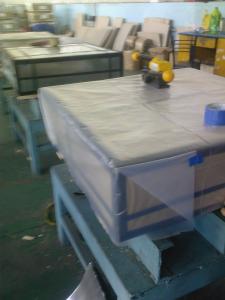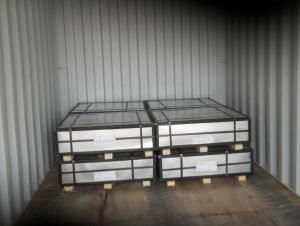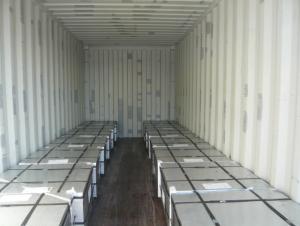Electrolytic Tinplate Coil and Sheets for Tin Cans Making
- Loading Port:
- Tianjin
- Payment Terms:
- TT OR LC
- Min Order Qty:
- 25 m.t
- Supply Capability:
- 7000 m.t/month
OKorder Service Pledge
OKorder Financial Service
You Might Also Like
1.Structure of Electrolytic Tinplate Coil and Sheets for Tin Cans Making Description
Electrolytic Tin Plate Coils and Sheets for Foods Metal Packaging, is one thin steel sheet with a coating of tin applied by electrolytic deposition. Tinplate made by this process is essentially a sandwich in which the central core is strip steel. This core is cleaned in a pickling solution and then fed through tanks containing electrolyte, where tin is deposited on both sides. As the strip passes between high-frequency electric induction coils, it is heated so that the tin coating melts and flows to form a lustrous coat.
2.Main Features of the Electrolytic Tinplate Coil and Sheets for Tin Cans Making
Appearance – Electrolytic Tin Plate is characterized by its beautiful metallic luster. Products with various kinds of surface roughness are produced by selecting the surface finish of the substrate steel sheet.
Paintability and printability – Electrolytic Tin Plates have excellent paintability and printability. Printing is beautifully finished using various lacquers and inks.
Formability and strength – Electrolytic Tin Plates have got very good formability and strength. By selecting a proper temper grade, appropriate formability is obtained for different applications as well as the required strength after forming.
Corrosion resistance – Tinplate has got good corrosion resistance. By selecting a proper coating weight, appropriate corrosion resistance is obtained against container contents. Coated items should meet 24 hour 5 % salt spray requirement.
Solderability and weldability – Electrolytic Tin Plates can be joined both by soldering or welding. These properties of tinplate are used for making various types of cans.
Hygienic – Tin coating provides good and non toxic barrier properties to protect food products from impurities, bacteria, moisture, light and odours.
Safe – Tinplate being low weight and high strength makes food cans easy to ship and transport.
Eco friendly – Tinplate offers 100 % recyclability.
Tin is not good for low temperature applications since it changes structure and loses adhesion when exposed to temperatures below – 40 deg C.
3.Electrolytic Tinplate Coil and Sheets for Tin Cans Making Images
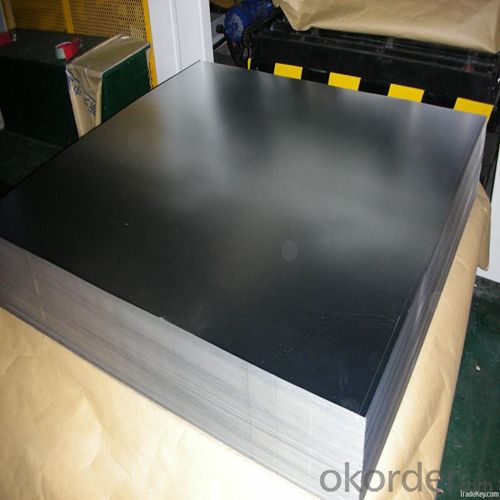
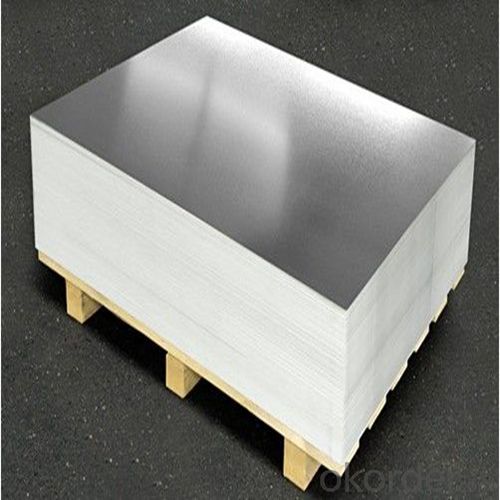
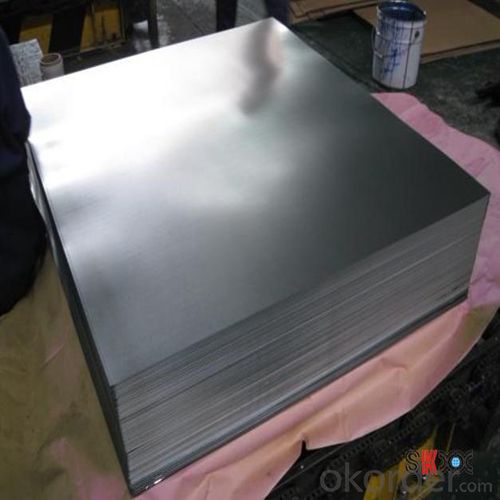
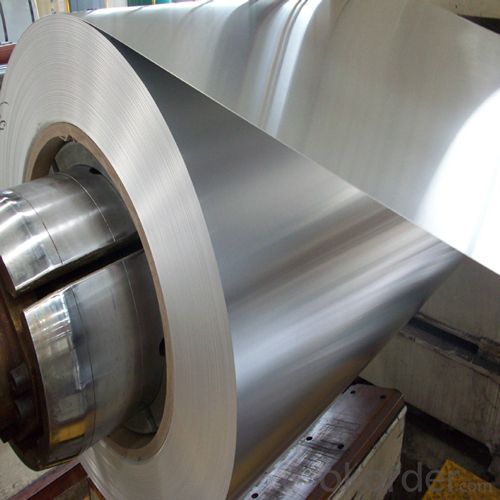
4.Electrolytic Tinplate Coil and Sheets for Tin Cans Making Specification
Standard | ISO 11949 -1995, GB/T2520-2000,JIS G3303,ASTM A623, BS EN 10202
|
Material | MR,SPCC |
Thickness | 0.15mm - 0.50mm |
Width | 600mm -1150mm |
Temper | T1-T5 |
Annealing | BA & CA |
Coil Inner Diameter | 508mm |
Weight | 6-10 tons/coil 1~1.7 tons/sheets bundle |
Passivation | 311 |
Oil | DOS |
Surface | Finish,bright,stone,matte,silver |
5.FAQ of Electrolytic Tinplate Coil and Sheets for Tin Cans Making
-How to place .an order or contact you ?
Please send us Email. we will give you a quick response in seconds .
- How is your quality ?
All our quality is prime even the secondary quality . We have many years experience
In this field with serious quality control standard . Advanced equipment, We welcome your visit to our factory .
- Q: How does tinplate packaging contribute to product differentiation?
- Tinplate packaging contributes to product differentiation by providing a unique and attractive look that distinguishes a product from its competitors. The use of tinplate allows for creative and eye-catching designs, which can effectively communicate the brand's identity and create a memorable impression on consumers. Additionally, tinplate packaging offers durability and protection, ensuring that the product remains in good condition throughout its shelf life. This enhances the overall perceived value of the product and sets it apart from alternatives, thus contributing to product differentiation.
- Q: What are the common storage and handling requirements for tinplate?
- The common storage and handling requirements for tinplate include keeping it in a clean and dry environment to prevent rusting or corrosion. It should be stored in a well-ventilated area away from direct sunlight and sources of heat. Tinplate should be handled with care to avoid any sharp impacts or bending, as it can affect its structural integrity. It is also important to stack tinplate properly, ensuring that there is no excessive weight on top of it to prevent deformation. Regular inspection and maintenance are necessary to detect any signs of damage or corrosion early on.
- Q: What are the different methods of joining tinplate components together?
- There are several methods for joining tinplate components together. Some common techniques include soldering, spot welding, adhesive bonding, and mechanical fastening. Each method has its advantages and is chosen based on factors such as the complexity of the assembly, desired strength and durability, and cost considerations.
- Q: Can tinplate be used for packaging personal hygiene products?
- Yes, tinplate can be used for packaging personal hygiene products. Tinplate is a commonly used material for packaging due to its durability, corrosion resistance, and ability to preserve the quality and freshness of products. It is commonly used for packaging various personal hygiene items such as soaps, shampoos, lotions, and cosmetics.
- Q: What are the applications of tinplate?
- Tinplate has a wide range of applications due to its protective and aesthetic properties. Common uses include packaging cans for food and beverages, aerosol containers, metal caps and closures, electrical components, and even decorative items. Its corrosion resistance and ability to maintain product freshness make it a popular choice for preserving and packaging various goods.
- Q: How does tinplate compare to other packaging materials in terms of cost?
- Tinplate is generally more expensive than other packaging materials such as aluminum or plastic.
- Q: What is the global demand for tinplate?
- The global demand for tinplate is significant and steadily growing due to its versatile applications across various industries, such as packaging, automotive, construction, and electronics. Tinplate's corrosion resistance, durability, and aesthetic appeal make it a preferred choice for manufacturing cans, containers, and other packaging materials. Additionally, the increasing focus on sustainability and recyclability has further boosted the demand for tinplate as it is highly recyclable.
- Q: How does tinplate packaging contribute to product freshness?
- Tinplate packaging contributes to product freshness by providing a protective barrier against oxygen, moisture, and light, which are factors that can deteriorate the quality and freshness of products over time. The airtight seal created by tinplate packaging helps to prevent oxidation and moisture absorption, preserving the flavor, aroma, and texture of the product. Additionally, tinplate packaging offers excellent light-blocking properties, which helps to protect light-sensitive products from degradation. Overall, the use of tinplate packaging plays a crucial role in extending the shelf life and maintaining the freshness of various products.
- Q: How does tinplate contribute to the protection of pharmaceutical products?
- Tinplate contributes to the protection of pharmaceutical products by providing a reliable and durable packaging material. Its corrosion-resistant properties prevent contamination and ensure the integrity and safety of the products. Additionally, tinplate's ability to block out light and oxygen helps to extend the shelf life of pharmaceuticals, maintaining their effectiveness over time.
- Q: What are the main applications of tinplate in the beverage industry?
- Tinplate is commonly used in the beverage industry for the production of cans and containers. Its main applications include packaging for carbonated drinks, beer, fruit juices, and other beverages. Tinplate provides excellent protection against corrosion, ensuring the freshness and quality of the product. It also offers high strength, easy formability, and good printability, making it an ideal choice for branding and product differentiation. Moreover, tinplate cans are easily recyclable, contributing to sustainability efforts in the industry.
Send your message to us
Electrolytic Tinplate Coil and Sheets for Tin Cans Making
- Loading Port:
- Tianjin
- Payment Terms:
- TT OR LC
- Min Order Qty:
- 25 m.t
- Supply Capability:
- 7000 m.t/month
OKorder Service Pledge
OKorder Financial Service
Similar products
Hot products
Hot Searches
Related keywords

